As one of the most well-loved and oldest type of food known to man (it dates back to the prehistoric times), pancakes are still very much in demand (and still loved) to this day. You can literally have it at any time of the day – because it can be eaten as breakfast, lunch, dinner, snack or dessert (depending on the variety healthy recipes).
It comes in many different variations (sweet or meaty, but always yummy) – and so, everyone can get and eat the type of pancake that he or she wants. Fortunately, this food is very easy to make – even at home.
If you want to know how to make pancakes, you’ve come to the right place. This article will cover everything you need to know about this delicious food. I will show you how to cook it, how to personalize each recipe, how to present it, and even how to eat it.
More...
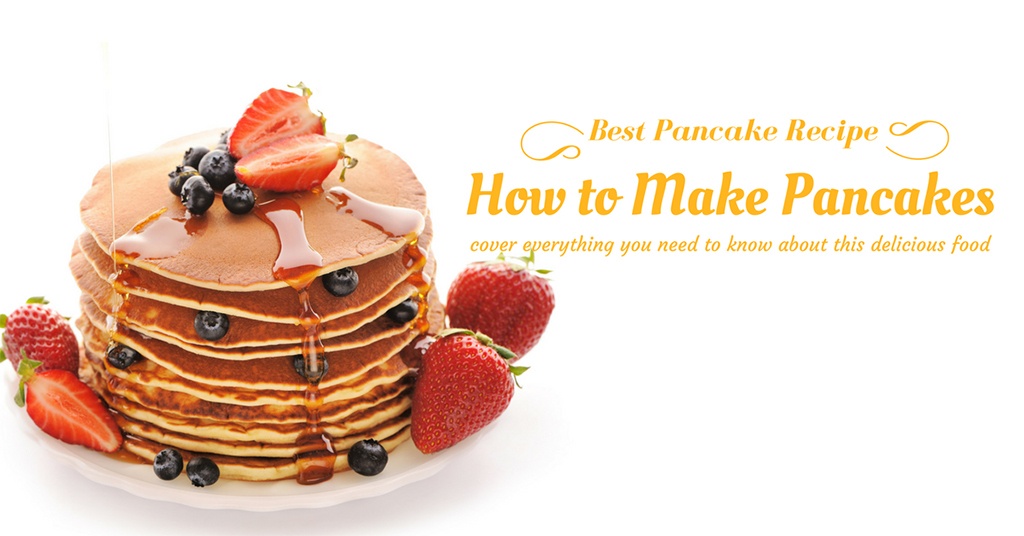
Overview of Pancakes
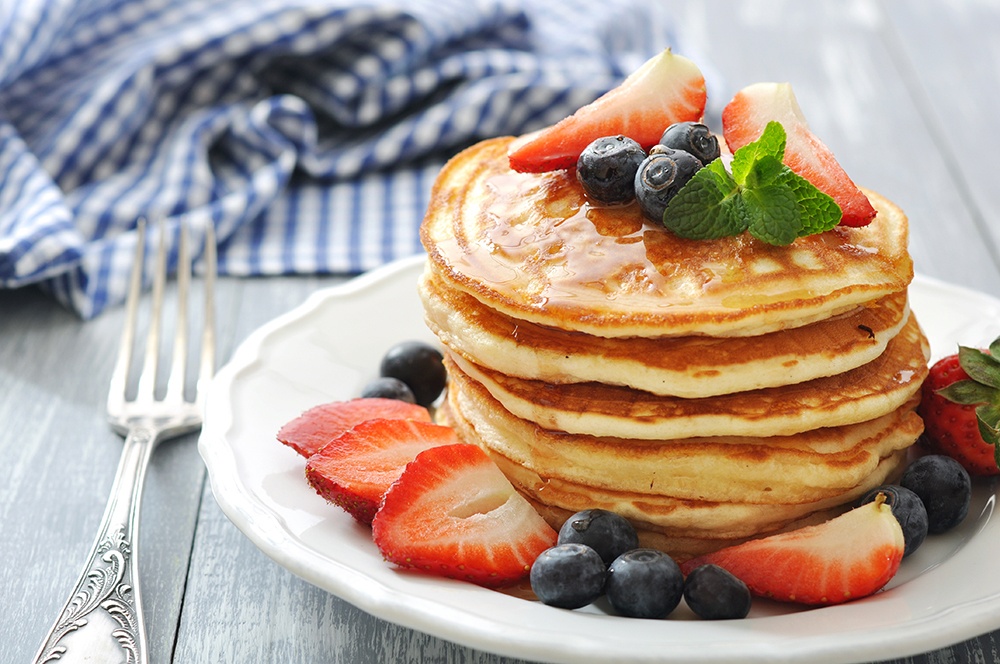
What is a Pancake?
A pancake goes by many different names, such as:
- Hotcake
- Flapjack
- Griddlecake
It’s a thin (about ½ inch), bread-like or cake-like type of food – and it’s also round in shape.
To make a pancake, you need a hot surface for cooking it – like a griddle or a frying pan. You can use a little oil if you’re not using a non-stick pan. But if you’re cooking on a non-stick pan, you can cook a pancake without using any oil.
Pancake Ingredients
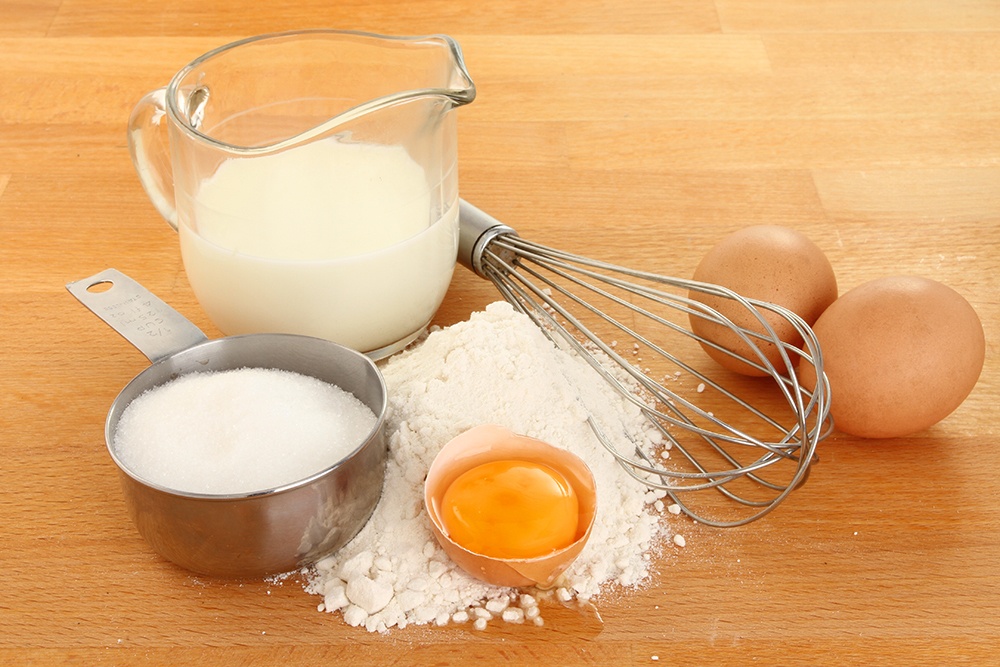
The ingredients in making a pancake will depend on the type of pancake and the toppings, fillings, and flavors that you’re using. A basic pancake, however, only needs these ingredients:
Flour
Milk
Egg/s
Butter
For flavoring, you can add the following ingredients:
Sugar
Vanilla extract
Nutmeg
Cinnamon
For the toppings and fillings, you can use these ingredients:
Preserves (jams and jellies)
Fresh fruits
Meat (cooked)
Chocolate chips
Syrup
And if you opt to use the frying method to cook pancakes, you can use any of these:
Oil
Butter
What Do Pancakes Taste Like?
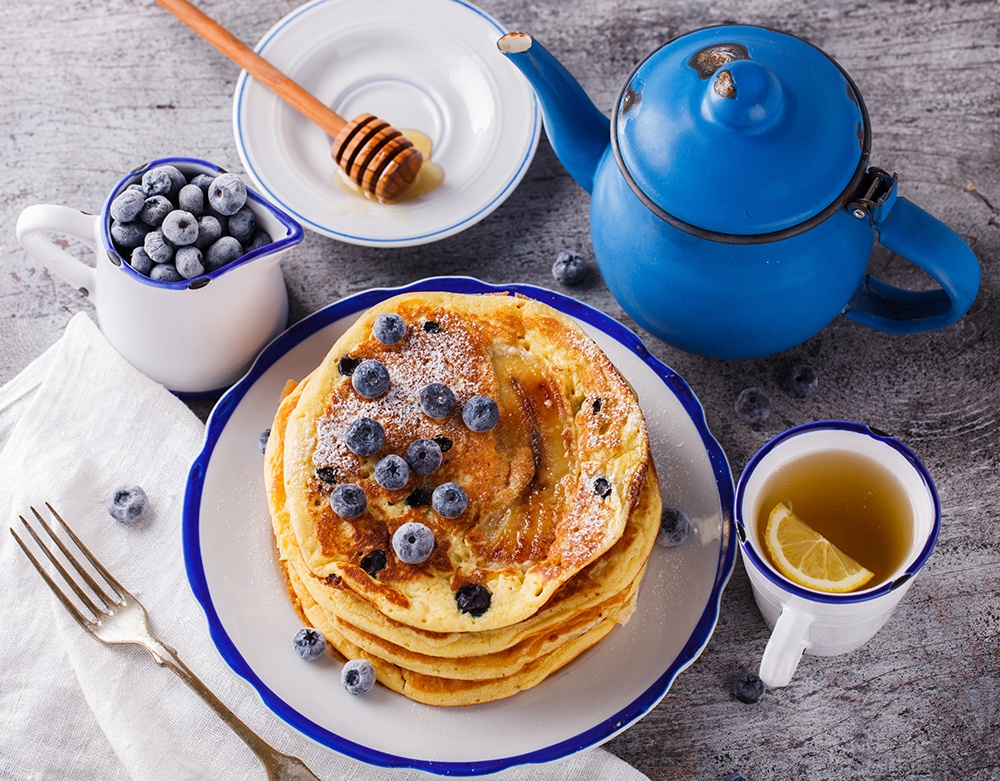
In general, we can say that pancakes taste good. Otherwise, it wouldn’t be everybody’s favorite, right? In the USA, it’s even preferred as everyday breakfast (other parts of the world also love eating this food for breakfast these days).
Pancakes are characterized by their fluffy texture – bready or cakey inside. Depending on a particular recipe, pancakes can also taste buttery and sweet. And of course, with additional sweet ingredients, toppings, and fillings – pancake recipes can come out sweeter.
They’re really popular that way (sweet), by the way – that’s why Maple syrup has proven to be the most popular topping for pancakes.
Now, if you’re making pancakes at home, make sure that your creations don’t taste too much like flour – as this shouldn’t be the case. Reduce the amount of flour next time, and you’ll end up with tastier and fluffier pancakes.
Note, too, that although eggs are included in a basic pancake recipe, they’re only there as a binding agent. Therefore, putting in too many eggs can make your pancakes taste eggy – which, again, should not be the case.
Pancakes Vs. Waffles

Waffles vs. pancakes Via amny
It’s not your imagination – pancakes and waffles do taste similar. The reason for this is that they have the same batter composition (flour and eggs). However, they are not exactly the same – in ingredients and in nature. To make it clearer, I have listed their differences below.
Texture
- Pancakes are soft outside, while waffles have crispy exteriors.
- Pancakes have fluffy, spongey interior – waffles, on the other hand, are light and soft inside.
Cooking
- Pancakes are cooked on a skillet or griddle (often using a little oil)
- Waffles are cooked in between 2 oiled metals (waffle maker or waffle iron)
Sugar and Fat Content
- In general, pancakes contain less percentage of sugar compared to waffles.
- Pancakes require less fat than waffles (waffles need more fat to achieve a crispy exterior)
Eggs
- Pancakes make use of fewer eggs than waffles as these only serve as binding agent.
- In waffles, more eggs are needed to make the cooked batter texture light.
Shape
- Pancakes are made to be round, but not perfectly round (there’s no need for a mold)
- Waffles can have round or square shapes – this will depend on the waffle maker’s design
Size
- Pancakes vary in size. They can have about an inch in diameter if made to be small and about the size of a plate if made to be big
- The size of waffles pretty much depends on the size of the waffle maker being used. The waffle iron will also determine the waffle’s thickness.
Toppings and Fillings
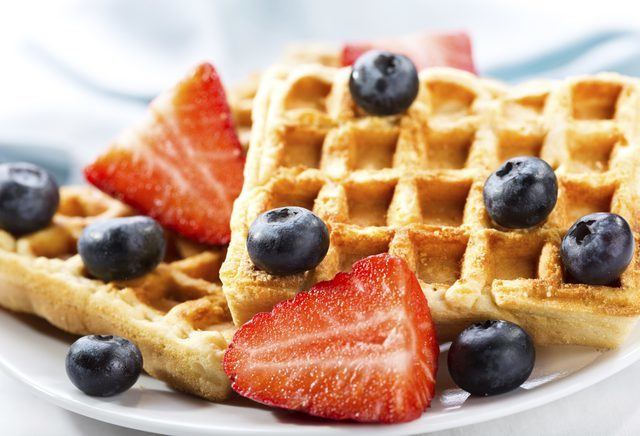
Difference Between Waffles & Pancakes Via leaf
You can use the same toppings for pancakes and waffles. In fact, the most common toppings for these two goodies are the following:
- Maple syrup
- Butter
Pancakes Vs. Crepes
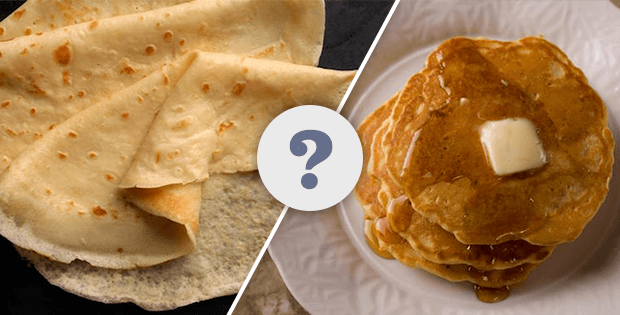
Difference Between Crepes and Pancakes Via chowhound
Pancakes and crepes are very similar in appearance that they are sometimes used interchangeably. Therefore, when a pancake becomes too thin, it can be called a crepe. But then, again, these are actually two different types of food as you will see in their comparisons below.
Appearance
- Although both pancakes and crepes are round in nature, pancakes are made to be thicker and fluffier
- Crepes are thin – so thin, in fact, that they’re almost transparent
Rising Agent
- To ensure that a pancake is going to be puffed up and fluffy, rising agents like baking powder and baking soda are used
- No rising agent is used in making a crepe, as it’s supposed to be very thin
Presentation and Fillings
- Pancakes can have fillings inside the batter. They can also be topped with sweet ingredients
- Crepes don’t have toppings. Instead, they’re served with yummy fillings inside (those that you can use as pancake toppings) and are folded and rolled to hold them in
Liquid Ingredients
- Pancakes aren’t supposed to be runny in order to have a somewhat thick presentation. Therefore, the flour to liquid ratio is kept under control so as to better manage the batter while cooking
- A crepe’s flour to liquid ratio involves the use of a lot of milk or water. This mixture allows the batter to spread thinly over the cooking surface and produce a thin, delicate result.
Great Side Dishes for Pancakes
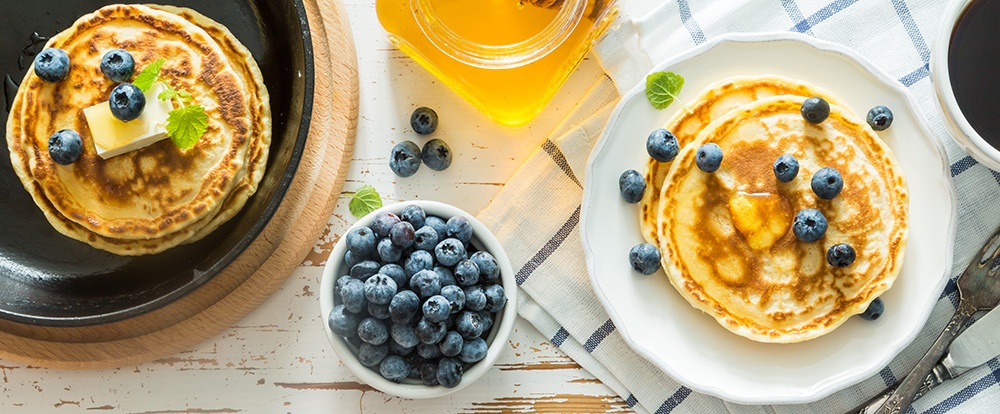
Pancakes are already great on their own and can be eaten without any additional side dishes, toppings, etc. However, here are just some of the few types of food and drinks that you can enjoy with pancakes:For drinks, the following complement pancakes well:
- Coffee
- Hot chocolate
- Orange juice (and other types of juices)
- Wine
Here are the most popular side dishes for pancakes:
- Bacon and eggs
- Sausages
- Cottage cheese and fruits
- Veggies (steamed or raw)
- Tuna salad
For toppings, consider these:
- Syrup
- Whipped cream
- Yogurt
- Nuts
Complete Guide to Cooking Pancakes
How to Prepare Ingredients
For this section, I will show you the proper preparation for the ingredients you need in making pancakes.
Dry Ingredients
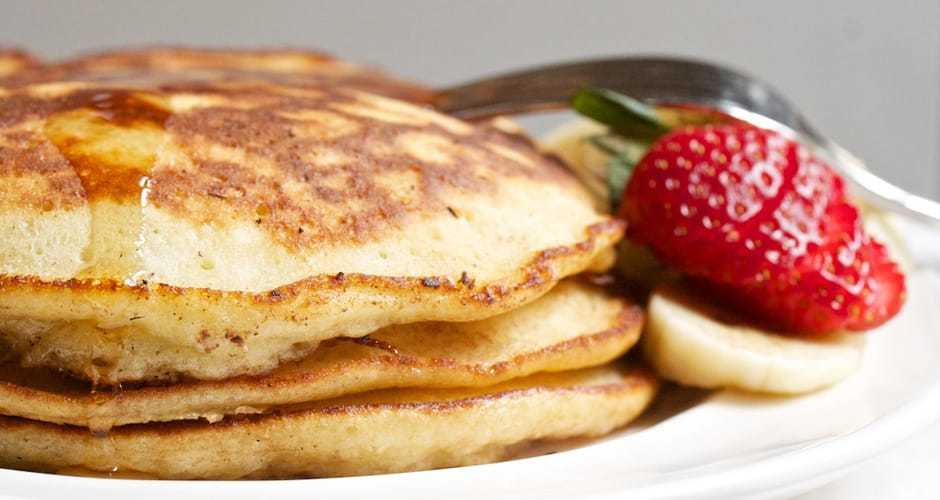
Dry ingredients to making pancakes Via firstwefeast
The dry ingredients to a basic pancake recipe are the following:
- Flour
- Baking powder
- Sugar
- Salt
Before proceeding with your pancake recipe, make sure that all dry ingredients are ready and properly measured.
Wet Ingredients
Here are the basic wet ingredients in making pancakes:
- Milk
- Melted butter
- Egg/s
- Vanilla extract
The important thing to remember when preparing the wet ingredients for your pancake recipe is that these should be at room temperature. It would be good to take them out of the refrigerator the night before if you’re going to have pancakes in the morning.
Eggs
The egg ingredient is included in the wet ingredients list, but here are additional instructions in its preparation:
- If you forgot to take the eggs out of the refrigerator the night before, you can speed up the process of bringing them to room temperature by soaking them in warm (not hot) water.
- When using eggs in your pancake recipes, separate the egg yolks from the egg whites. You can immediately combine the yolks with the other wet ingredients. As for the egg whites, beat these with a whisk as this step will help make the pancakes fluffier.
Milk
Aside from using milk at room temperature, know that these are some of the best types of milk in homemade pancake recipes:
- Whole cow’s milk
- Buttermilk
- Coconut milk
- Almond milk
- Soy milk
4 Alternative Flours
Yes, you can use our old, reliable All-purpose flour in making pancakes – but there are alternative flours that you can also consider using. No, these are not necessarily healthy types of flour – but they’re flavorful flours that will result in creamy, light, and fluffy pancakes.
These flours taste good in themselves that you barely need any toppings to enjoy your pancakes to the fullest. Try to look for these alternative flours the next time you cook pancakes:
- Spelled Flour – This type of flour has leavening characteristics, and using it will result in airy, fluffy pancakes. Its taste complements well with citrus flavors – so, you can match it with lemon and orange flavored drinks and toppings.
- Almond Flour – This flour makes for a great option if you want gluten-free pancakes. Needless to say, topping it with almond bits will enhance the pancake’s overall taste. It also goes well with other toppings, especially coconut milk whipped cream.
- Brown Rice Flour – Made from whole grain brown rice, here’s another gluten-free alternative to All-purpose flour. Its mild flavor makes it a great pair for banana fillings and toppings – and of course, butter.
- Buckwheat Flour – Buckwheat flours are not made of wheat (and therefore, gluten-free). Buckwheat pancakes go well with these fillings:
- Ham
- Cheese
- Eggs
How to Make Great Batter
Since the success of your pancake will largely depend on how the batter is made, you shouldn’t take it for granted. Follow the steps I listed below.
STEP 1 | You should have 3 sets of ingredients ready for the batter:
|
STEP 2 | Combine the dry and wet ingredients first. Do this by making a well at the center of the dry ingredients and pouring the wet ingredients in there. You can then begin the mixing process until everything is well-combined. (Remember to not overmix, ok?) |
STEP 3 | When the dry and wet ingredients are already combined, add in the egg whites in batches (depends on how many eggs you used in the recipe). Do this step gently – folding the whisked egg whites ever so carefully in the mixture and (again) not over mixing everything |
STEP 4 | Cook over medium heat by spooning the batter in the griddle or pan. Flip over when one side is done (golden brown) and remove from heat when the pancake is cooked. |
STEP 5 | Serve and enjoy |
How to Make Homemade Frying Batter : Fry It Up! Via cookingguide
How to Make Gluten-Free Batter
If you want to make gluten-free pancakes, you can use the following ingredients when making your pancake batter:
- Rice flour
- Tapioca starch
- Potato starch
- Buttermilk powder
- Sugar substitute
- Baking soda
- Baking powder
- Xanthan gum
- Eggs
- Canola oil
- Water
- Salt
As for the steps in preparing the batter for the gluten-free method, you will notice that the steps are basically the same: (the rule on using ingredients at room temperature also applies here)
STEP 1 | Combine the dry ingredients first. |
STEP 2 | Combine all the wet ingredients. (Note: for fluffier pancakes, separate the egg whites and beat these separately with a whisk) |
STEP 3 | Combine dry ingredients, wet ingredients, and egg whites and mix well (but not over mixed) |
STEP 4 | Spoon batter into a hot frying pan (sprayed with oil) |
STEP 5 | Flip over once the bottom side is already cooked (golden brown) |
STEP 6 | Remove from pan and serve hot |
Gluten-Free Fish Batter Recipe : Gluten-Free Recipes Via cookingguide
How to Cook Pancakes
Once your batter is ready, it’s time to cook the pancakes. Keep in mind, however, that cooking pancakes don’t just require scooping batter into a frying pan. To make the perfect pancakes, keep the following points in mind:
- Have a hot pan ready before pouring any pancake batter mixture in it. The batter will stick to a cold pan and just ruin everything (its appearance, taste, your confidence in cooking, etc.)
- For a really smooth cooking procedure, grease the surface of your cooking pan. Ghee and clarified butter work the best for pancakes as they don’t burn quickly. However, you can also use butter – but don’t get it too hot as butter can burn easily (and also affect the taste and appearance of your pancakes)
- You can turn down the heat when you’re already cooking the pancakes
- You can use a spoon or a cup to pour batter into the pan. The standard size for a pancake is about ¼ cup
How to Make Easy Pancakes Via Allrecipes
How to Flip Pancakes
Flipping pancakes can be quite tricky if you’re a beginner, but you can easily get the hang of it with enough practice. There are also certain techniques that you need to know to perfect this step in making pancakes. Don’t worry, I’ve listed the steps to flipping pancakes below.
STEP 1 | Wait for the top surface to have bubbles, wait for these bubbles to pop – and that’s your signal that it’s time to flip the pancake. (at this point, you will also notice that it’s a bit puffed up) |
STEP 2 | Gently lift the bottom surface of the pancake with a spatula to flip it. Don’t worry, when cooked, it will easily release from the pan and the mixture will already be somewhat solid |
STEP 3 | With a quick movement of the wrist, flip the pancake to the other side. |
STEP 4 | Keep in mind that the second side will cook faster as the pancake is already half done at this point. You will know it’s cooked when it’s colored golden brown and is released easily from the pan. |
STEP 5 | Remove the pancake from the pan and place in a serving dish. |
How To Flip A Pancake - Sainsbury's Via Sainsbury's
How to Use Fillings and Add-Ons
If you want to get a little creative with your basic pancakes, you can add some fillings to make them extra special. Adding fillings to pancakes is not a very complicated method – once you know how to do it, that is. So, just do the following steps:
STEP 1 | Prepare the pancake batter as usual. For best results, DO NOT add the fillings in the batter. |
STEP 2 | Scoop or pour batter into the hot pan |
STEP 3 | Place in the necessary fillings on top of the uncooked batter surface. |
STEP 4 | Add more batter mixture onto the filling ingredients to close the batter up. |
STEP 5 | Flip the pancake mixture as soon as the bottom surface is cooked (golden brown color) |
STEP 6 | Allow the other side of the pancake to cook as well. |
STEP 7 | Remove from heat and serve |
How to Make Pancake Toppings
Anything delicious qualifies as a pancake topping – you just need a little imagination and some creativity to make your pancakes attractive and delicious as well. Here are just some of the most common ingredients used as pancake toppings:
- Nuts (almond, hazelnut, etc.)
- Fruits (bananas, berries, etc.)
- Chocolates (chips, syrups, etc.)
- Whipped cream
- Syrups and liquid sweeteners (maple syrup or honey)
8 Tips and Tricks to Making Pancakes
Tip 1 – How to Make Pancakes Without Baking Powder
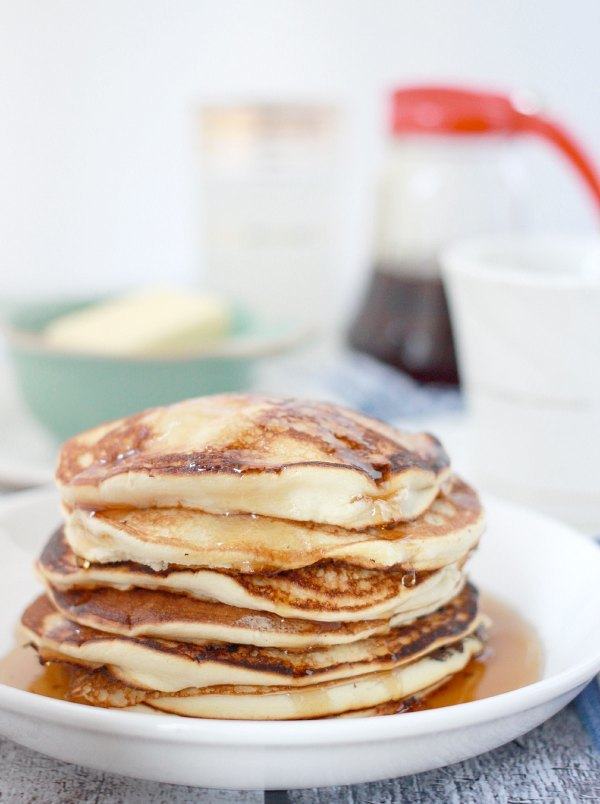
Fluffy Meringue Pancakes: Pancake Recipe Without Baking Powder Via bakerbettie
Baking powder is a leavening agent, and you need it in making pancakes so as to make them rise and fluffy. Should you find yourself out of baking powder, use baking soda instead. Baking soda is also a leavening agent, and you will get the same results.
See Food.com’s pancake recipe that uses baking soda instead of baking powder
Now, should you also be out of baking soda, you can still make fluffy pancakes. This time, you will rely on the egg ingredient to make your pancakes “airy” and fluffy.
The method includes beating the egg yolk and egg whites separately – with the egg whites beaten until the mixture becomes frothy (this is then mixed with the butter mixture on standby). For a video on how to do this technique.
How to make pancakes without baking powder and soda Via Now You Know It! [Cooking]
Tip 2 – How to Make Pancakes Without Eggs
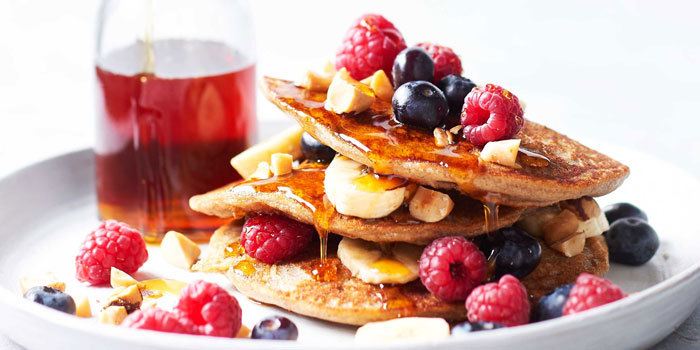
How to make pancakes without eggs Via bbcgoodfood
You have the option of making pancakes without eggs if you suddenly find that you don’t have any eggs in the refrigerator. This is also good news for those who simply want to make eggless pancakes (or are allergic to eggs).
You see, eggs are used in pancake recipes as a binding agent. However, with some adjustments in the dry and wet ingredients (and being extra careful), you can still make beautiful, soft, round pancakes without this ingredient. Here’s a really yummy eggless pancake recipe to try out today.
How to Make Pancake Batter Without Eggs, Yeast or Butter : Healthy Pancakes Via cookingguide
Tip 3 – How to Make Pancakes Without Milk
Although a basic pancake recipe calls for milk ingredient, you can actually make this delicious food without milk (for whatever reason). Basically, the other liquid ingredients (especially water) will take the place of milk – so, you can still end up with soft, creamy pancakes in the end.
Here’s a really good recipe of pancake made without milk. Believe me, no one will think that you made your homemade pancakes without milk.
Pancakes without Milk or Eggs Via CFB
Tip 4 – How to Make Pancakes Without Flour
You might think that a pancake recipe calls for the use of flour all the time. While a basic pancake recipe is indeed dependent on flour for the batter, said ingredient can be substituted, too.
The best substitute for flour in making pancakes is the banana. Yes, you read that right. Ripe bananas can be mashed in such a way that this ingredient can take the place of flour in pancakes. The result is actually a healthier form of pancake – gluten-free, low-calorie, and high in vitamins and minerals.
Here’s a really good pancake recipe that only uses 3 ingredients – bananas, eggs, and baking powder (no flour). You can make a banana flavored pancake with this recipe because it’s the main ingredient is the banana. The eggs serve as the binding agent, and the baking powder will make your pancakes fluffy. (special tip: small pancakes are easier to flip and manage)
No Flour Pancakes Via Lisa Scott's Fitness
Tip 5 – How to Make Fluffy Pancakes
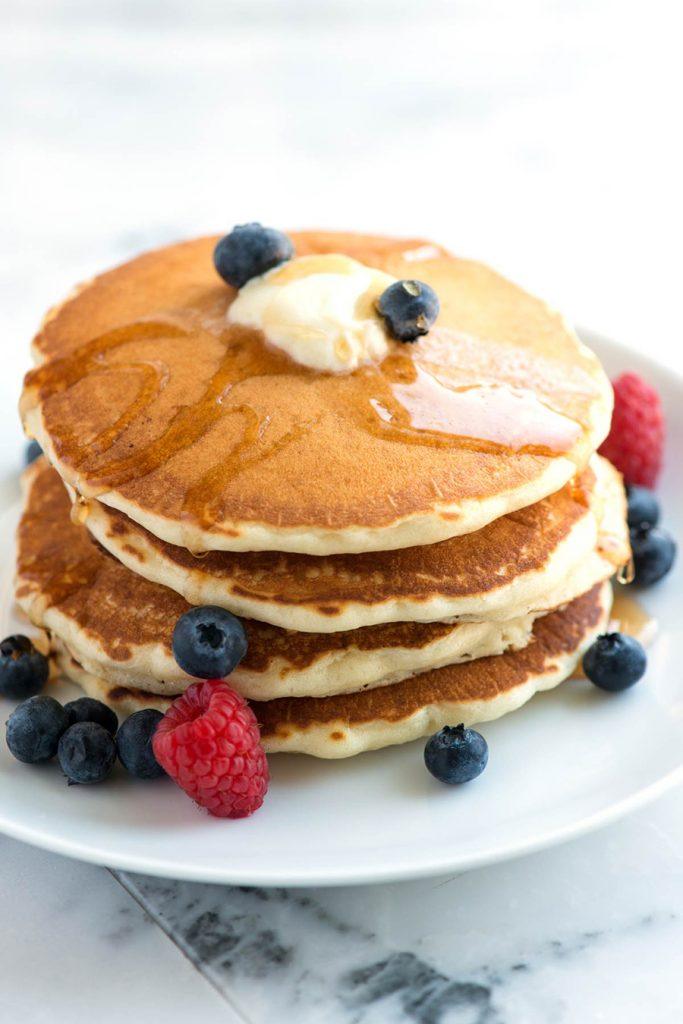
Easy Fluffy Pancakes Recipe Via inspiredtaste
To make really fluffy pancakes, you should have a leavening agent included in the recipe (baking powder or baking soda). Aside from the leavening agents, however, using buttermilk will give you the best fluffy results.
Unfortunately, not everyone stocks up on buttermilk. And in some places, this type of milk is even hard to find. Fortunately, you can make your own buttermilk by combining regular milk and an acid ingredient (vinegar or lemon juice).
When you combine these 2 ingredients and let the mixture sit on the counter for a while (about 10 minutes), you will have your very own homemade buttermilk (substitute) for your pancake recipe.
Click here for a fluffy pancake recipe. It uses buttermilk substitute – so, you’ll get an idea as to how making your own buttermilk substitute is done at home.
How to make Pancakes - Fluffy Pancake Recipe Via Carina Stewart
Tip 6 – How to Store Pancakes
Just like other types of food, the best way to store cooked pancakes is to keep them in the freezer. Follow these steps if you want to freeze pancakes for later consumption:
STEP 1 | Freshly cooked pancakes should be cooled completely before storing them in the freezer |
STEP 2 | Get a baking tray to hold your pancakes as they freeze. Use a parchment paper lining to hold pancakes while they’re being frozen in the freezer. The pancakes should be positioned apart from one another. And if you need to make another layer of pancakes, just put another sheet of parchment paper on top of each layer |
STEP 3 | Freeze the pancakes in the freezer for about 6 hours |
STEP 4 | Once frozen, you can stack the pancakes over each other. You can then keep them sealed up in freezer bags |
STEP 5 | Put a label on the frozen pancakes (date of storage) |
How to Make Freezer/Toaster Pancakes Via How Jen Does It
Tip 7 – How to Reheat Frozen Pancakes
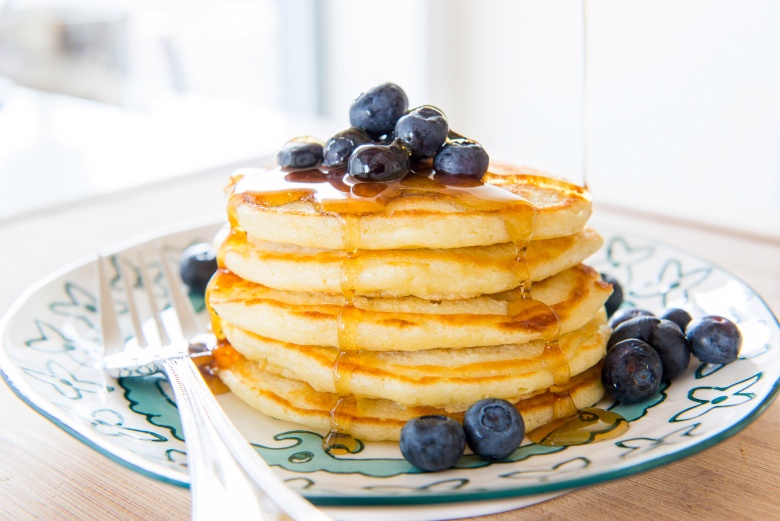
How to Freeze and Reheat Pancakes Via thepioneerwoman
When you are ready to serve your frozen pancakes, you need to reheat them first. Here are the steps to reheating frozen pancakes in the oven:
STEP 1 | Reheat oven to 350 degrees Fahrenheit |
STEP 2 | Get a baking tray and line it up with parchment paper. |
STEP 3 | Arrange pancakes onto the baking tray (single layer) and cover with aluminum foil |
STEP 4 | Bake for 10 to 15 minutes or until heated thoroughly |
STEP 5 | Serve and enjoy |
You can also reheat frozen pancakes in the microwave by following these steps:
STEP 1 | Get a microwave-safe container |
STEP 2 | Stack up pancakes into the microwaveable container |
STEP 3 | Heat on high for 1 to 2 minutes or until the pancakes are totally heated through |
Tip 8 – How to Store Pancake Batter
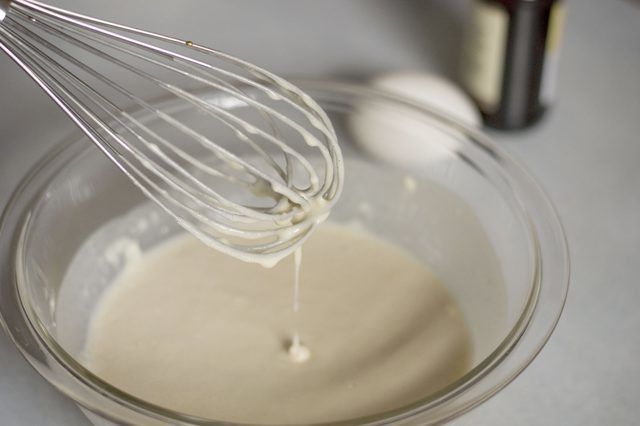
How to Store Leftover Pancake Batter Via leaf.tv
If you want to store pancake batter instead of cooked pancakes, you can also do so. This method actually works well for batter mixtures that have leavening agents (baking powder or baking soda) as resting the mixture will result in fluffier pancakes. Follow these steps when storing pancake batter:
STEP 1 | Transfer the batter mixture into a tightly sealed container |
STEP 2 | Keep the batter mixture container in the refrigerator (this will stay fresh in the fridge for about 5 days) |
STEP 3 | Store the batter mixture in the freezer to prolong its life indefinitely |
STEP 4 | To thaw frozen pancake batter, simply place it in the fridge overnight. Slightly mix the batter before cooking |
Bonus Tips and Tricks
Here are more quick tips to making the perfect pancakes:
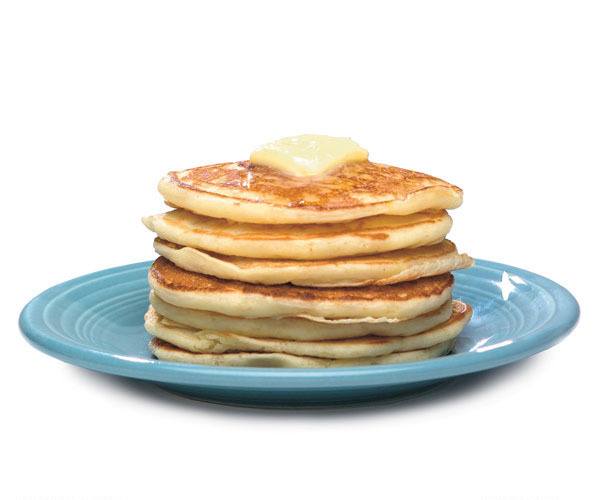
The Secrets to Making Great Pancakes Via finecooking
- To achieve room temperature eggs in a jiffy, place the eggs in warm water for about a minute
- You can heat cold milk in the microwave for about 30 minutes to quickly achieve room temperature
- Pour wet ingredients into dry ingredients instead of the other way around, as this method provides you with better control over the ingredients that you’re mixing
- For best results, always mix the dry ingredients and wet ingredients separately. This technique allows for smoother and more even consistency in the better.
- Allowing the batter to rest for about 5 minutes before cooking results in smoother and softer pancakes. This process allows the gluten formed during the mixing process to relax and lumps will also diminish during the resting period.
- Do not overmix as this will result in tough pancakes. It’s normal to have lumps in the batter – there’s no need for you to keep mixing until all the lumps are gone.
- Make sure that the pan is very hot before pouring in the batter mixture. Cooking on a cold pan will make the batter stick and ruin the shape and appearance of your pancakes.
- Bubbles will form on the surface of the pancake as a signal that it’s time for you to flip it to the other side. You don’t need to wait for all the bubbles to pop up before flipping the pancake. When the bottom surface is already cooked (golden brown) and releases easily from the pan, you can flip the pancake to the other side.
- Don’t flatten the pancake as it cooks. It’s supposed to be fluffy, remember?
8 Common Mistakes When Cooking Pancakes
Mistake 1 – Overmixing the Batter to Make it Smooth
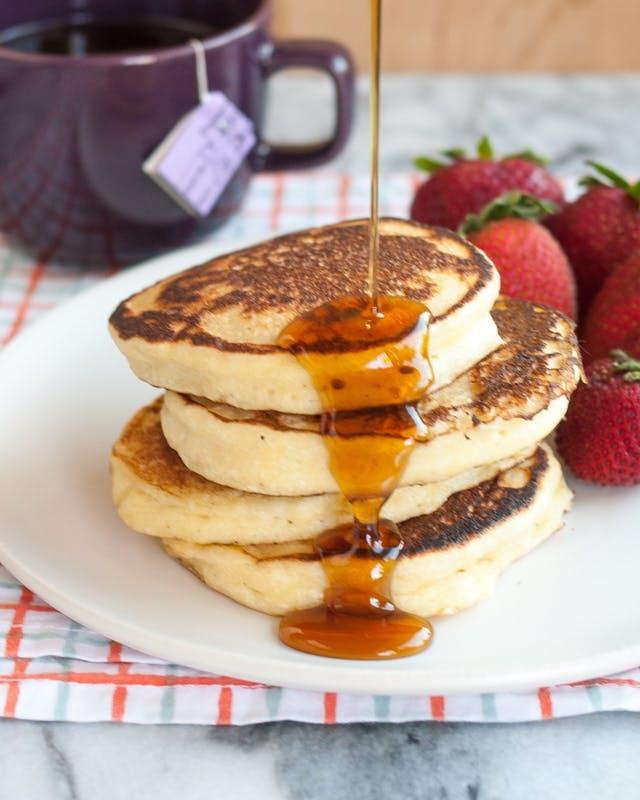
5 Common Mistakes to Avoid When Making Pancakes Via thekitchn
Overmixing the pancake batter will make the final result tough instead of soft and fluffy. You see, gluten forms as soon as you mix the dry and wet ingredients – and the more gluten formed, the chewier and tougher the final pancakes will become.
As long as the dry and wet ingredients are thoroughly combined, you can stop the mixing process (the lumps will disappear during the cooking process, you know).
Mistake 2 – Not Resting the Batter
Resting the batter can be anywhere from 5 to 30 minutes. This period of rest will allow the gluten formed during the mixing process to somehow relax so as not to make your pancakes tough and hard.
Mistake 3 – Not Making the Pan Hot Enough
The pancake batter will stick to the pan when it’s cold. Aside from that, the pancake will also absorb all the oil in the pan and make the final result greasy.
Mistake 4 – Using Very High Heat
While the pan needs to be very hot, you shouldn’t cook your pancakes at a very high temperature – yes, even if you’re in a hurry. Cooking at a very high temperature will result in uneven cooking – with the interior still raw and the exterior overcooked or burned.
Mistake 5 – Flipping Too Many Times
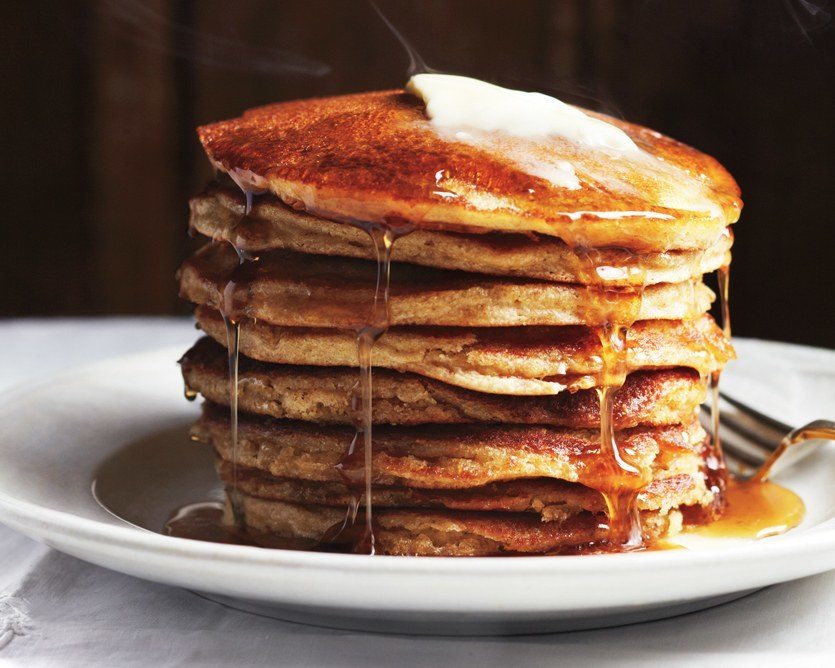
10 Pancake Common Mistakes—and How to Avoid Them Via bonappetit
You only need to flip the pancake once – as flipping too many times will result in deflated pancakes (when they’re supposed to be fluffy). If you flip at the right time (when bubbles have already popped on the surface), there’s no need to flip again.
Mistake 6 – Using Old Ingredients
Fresh ingredients are always important in cooking – and it’s the same thing with pancakes. Using high-quality ingredients will yield the best (most delicious) results. In fact, using an old stock of baking soda (more than 6 months old) will affect the fluffiness of your pancakes (as it will not be in its best condition as a leavening agent).
Mistake 7 – Not Using the Right Pan
The right cooking pan will contribute to your success in making the perfect pancakes. Keep these things in mind:
- Your pan should be wide enough to flip the pancake with ease
- Your pan shouldn’t be too thin to avoid burning the pancakes
- Don’t use a pan with slopes on the sides, as this will make flipping and maneuvering pancakes really hard.
- Don’t pour oil in the pan when cooking pancakes as having a pool of oil in one part of the pan can result in uneven cooking. Moreover, too much oil will result in greasy pancakes.
Mistake 8 – Not Measuring Ingredients
Always follow the measurements in a particular recipe that you’re using and have the proper measuring tools. Measuring cups and measuring spoons are your best friends in cooking.
Experts' Advise
AllRecipes.com
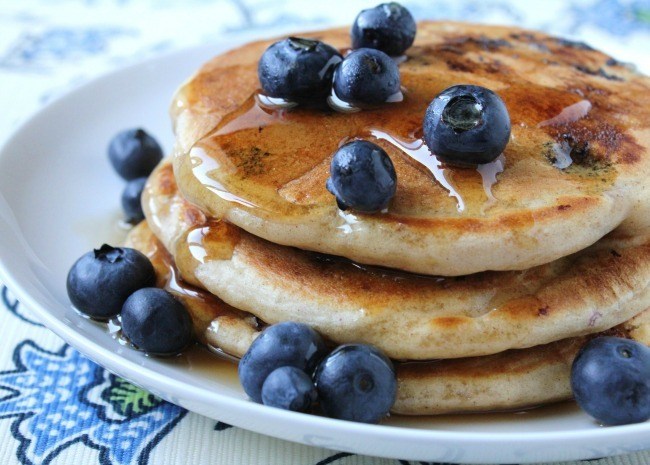
How to Make the Best Pancakes From Scratch Via allrecipes
AllRecipe.com’s food expert Vanessa Greaves advise against pouring pancake batter directly into the cooking pan. Instead, she recommends using a cup or a squeeze bottle to properly measure the amount of batter that will go into each pancake. She also suggests the following:
- If you’re using a large griddle, you can place several batches of batter (with ample spaces between them) in one cooking
- Having browned sides and popped up bubbles are some of the signs that it’s time to flip the pancakes.
- Don’t press on the pancakes for faster cooking. This will not speed up the cooking process, but will simply deflate the pancakes (which are supposed to be fluffy)
ThePioneerWoman.com
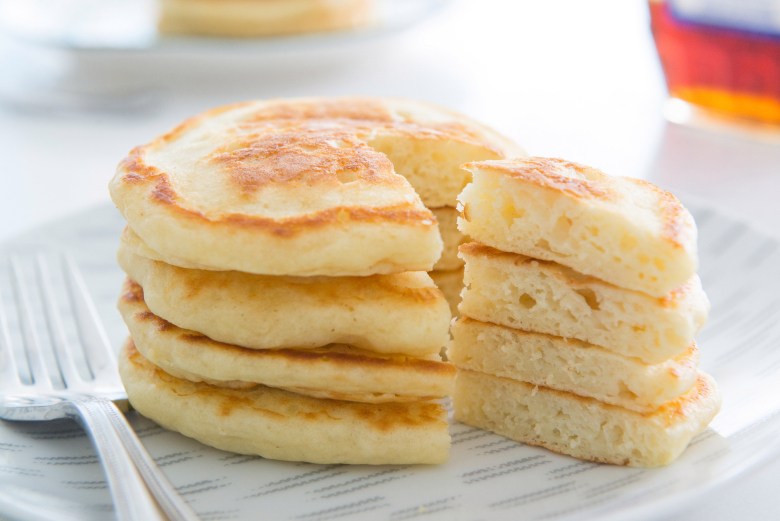
Best Tips for Making Pancakes Via thepioneerwoman
Joanne of ThePioneerWoman.com is also the food expert behind the Fifteen Spatulas blog. She also has a YouTube channel where she shares her expertise in cooking different types of food (including pancakes, of course). She has these tips to share with us:
- Always use real buttermilk for the best tasting pancakes. Only use buttermilk substitutes (milk + vinegar or lemon juice) when you’re in a pinch. Real buttermilk will produce the best consistency, fluffiness, and flavor in pancakes.
- Add sugar in the batter itself to add some sweetness to the pancakes themselves (and therefore, not rely on sweet toppings too much). For best results, add the sugar with the other dry ingredients when preparing the pancake batter.
JamieOliver.com
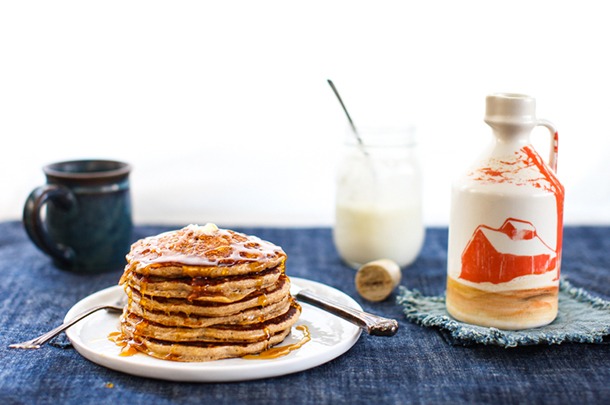
Simple tips for perfect pancakes Via jamieoliver
A contributor at JamieOliver.com, Aimee Wimbush-Bourque is also the woman behind the Simple Bites blog (an award-winning blog). This former chef has the following tips in cooking pancakes:
- Use whole grain flour instead of All-purpose flour as this is healthier
- For flavorful pancakes, always use buttermilk and butter
- Use cast iron pan and cook pancakes over medium heat for even cooking
TheSpruce.com
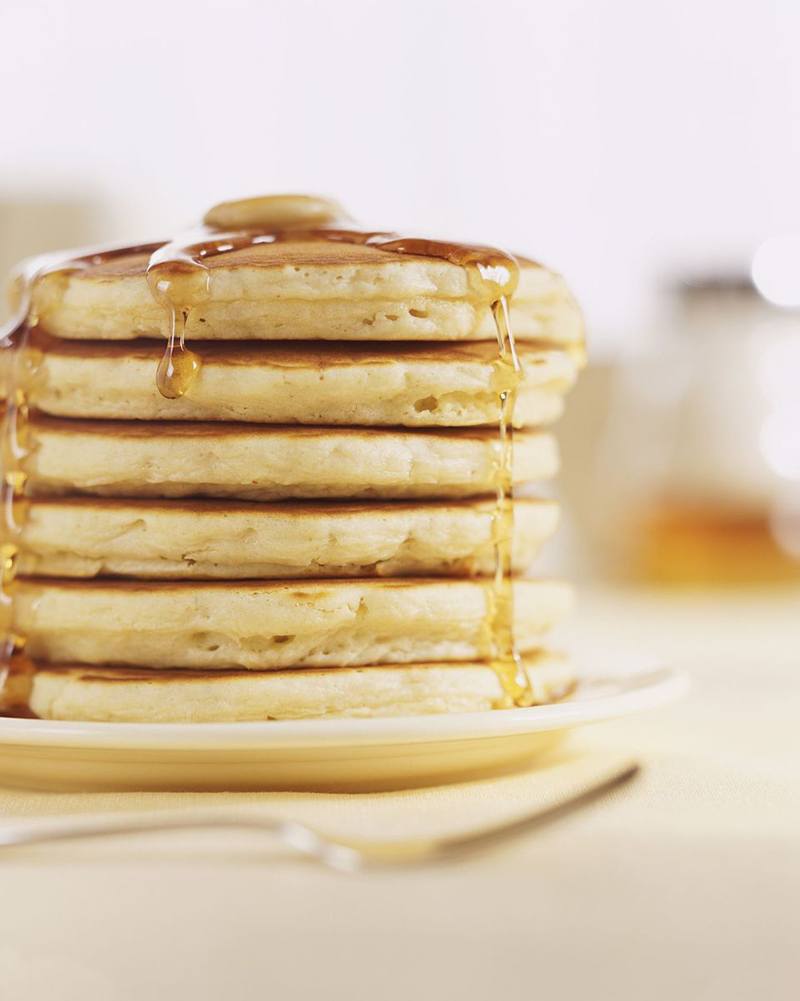
How to Make Pancakes Via thespruce
Expert food writer Stephanie Gallagher of TheSpruce.com has the following tips for making the best-tasting pancakes:
- Preheat pan before adding oil or butter to cook pancakes
- Use a measuring cup for evenly-sized pancakes. The standard size for pancakes is the ¼ cup of batter
SeriousSeats.com
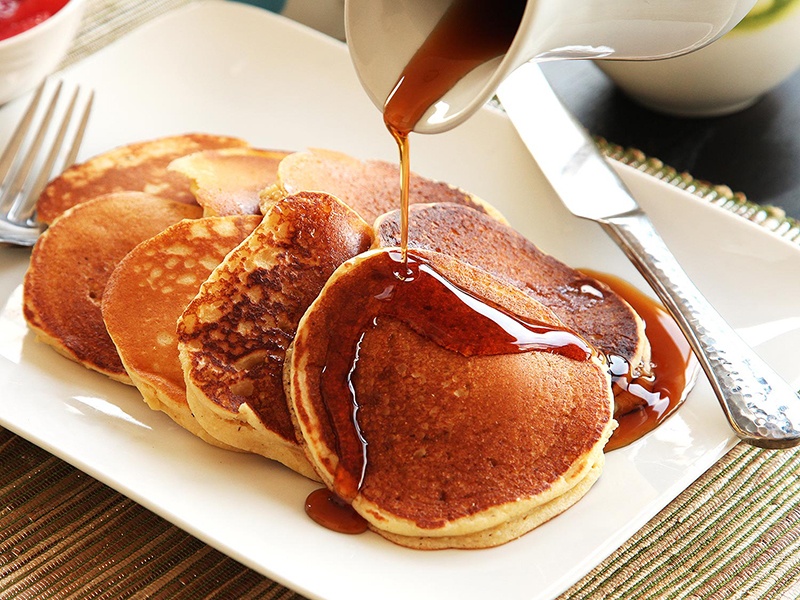
How to Make the Best Light and Fluffy Pancakes Via seriouseats
J. Kenji Lopez-Alt, managing culinary director at SeriousSeats.com has these to say about substituting buttermilk in recipes:
- Using vinegar or lemon juice will leave an acidic taste to the pancake batter.
- Use other soured dairy products like sour cream or yogurt as the substitute for buttermilk
Top 10 Pancake Recipes
Top 1 – Banana Pancake
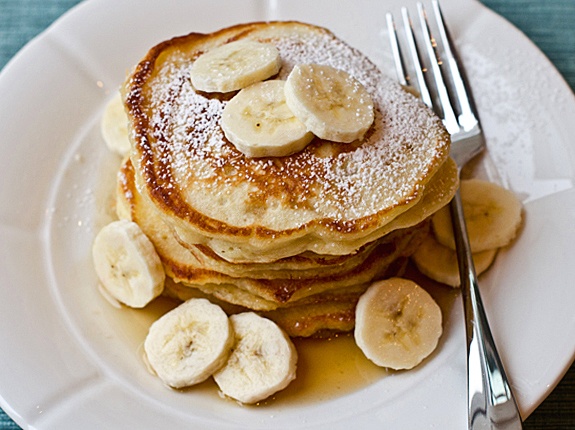
Banana Pancakes Via onceuponachef
Banana pancake recipes are one of the simplest yet most delicious homemade food. It’s banana flavored, of course. But since it uses real bananas, you will also benefit from the fruit’s natural vitamins and minerals. This particular recipe calls for the following ingredients:
- All-purpose flour
- Bananas
- Egg
- Sugar
- Salt
- Baking powder
- Milk
- Oil
Use really ripe bananas that are naturally sweet, so that you can minimize the use of syrup and other sweeteners.
Top 2 – Buttermilk Pancakes
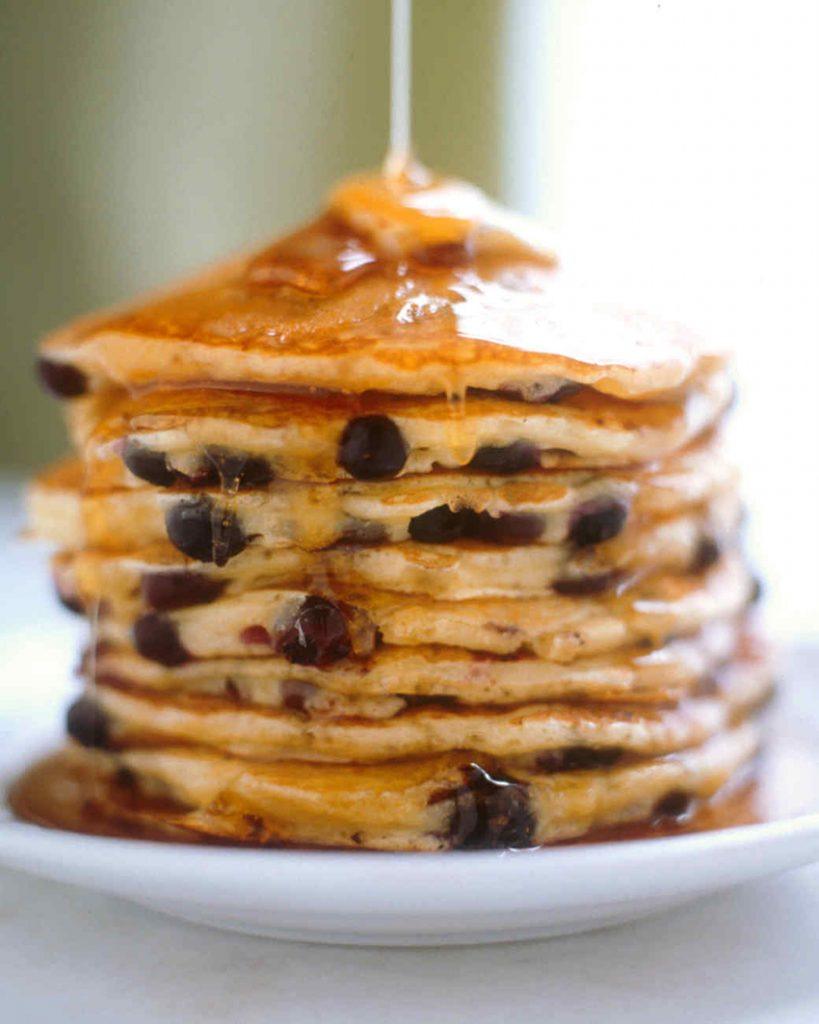
Best Buttermilk Pancakes Via marthastewart
Buttermilk pancakes are basic pancakes that are flavorful and delicious. Since buttermilk is a little bit sour, adding sugar to the batter makes it delicately balanced even without additional flavorings. You only need a few things to make this delicious pancake recipe, such as the following:
- All-purpose flour
- Buttermilk
- Eggs
- Baking powder
- Baking soda
- Sugar
- Salt
- Butter
You can eat this pancake as it is or tops it off with butter and cranberry syrup.
Top 3 – Classic Potato Pancakes
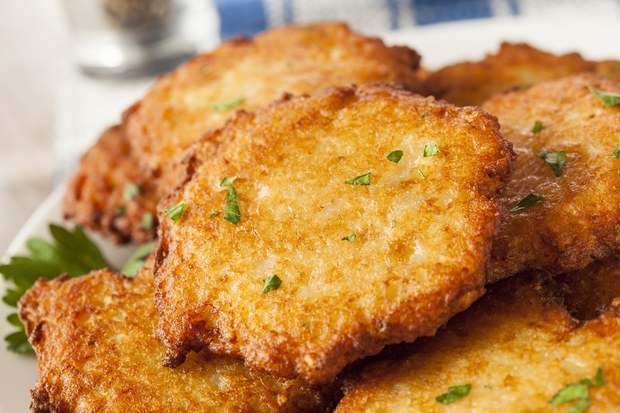
CLASSIC POTATO PANCAKES Via epicurious
You will be using potatoes as the main ingredient in this pancake recipe – therefore, only minimal flour is required. Here are the ingredients needed to make this one-of-a-kind pancake recipe:
- Potatoes
- Onion
- Eggs
- All-purpose flour
- Oil
- Butter
These potato pancakes are delicious, especially when served with applesauce or sour cream.
Top 4 – Oatmeal Pancake
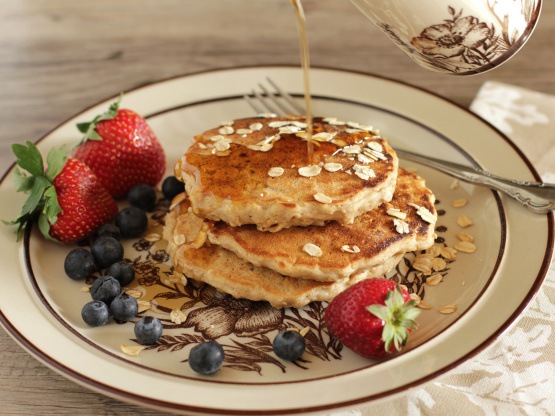
Family Favorite Oatmeal Pancakes Via food
Here’s a healthy pancake recipe that you will surely enjoy. It requires minimal ingredients and cooking steps – so, your pancakes will be ready for serving in just a few minutes. Here are the ingredients you need to make this particular recipe:
- All-purpose flour
- Oatmeal
- Eggs
- Baking powder
- Salt
- Milk
- Oil
Use fat-free milk for a really healthy version of this pancake. And of course, you can always replace the all-purpose flour with whole wheat flour.
Top 5 – Blueberry Buttermilk Pancakes
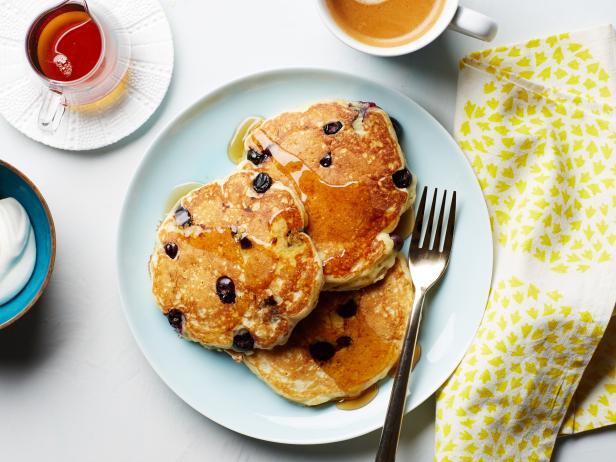
Blueberry Buttermilk Pancakes Via foodnetwork
This recipe will give you sweet, blueberry-flavored pancakes that are simply hard to resist. It also uses buttermilk – so, you can already imagine each bite of pancake to be bursting with flavors. Here are the ingredients needed to make this type of pancake:
- All-purpose flour
- Buttermilk
- Eggs
- Sugar
- Baking powder
- Baking soda
- Butter
- Blueberries
Serving this blueberry buttermilk pancake with maple syrup and whipped cream would really enhance its taste.
Top 6 – Pumpkin Pancakes
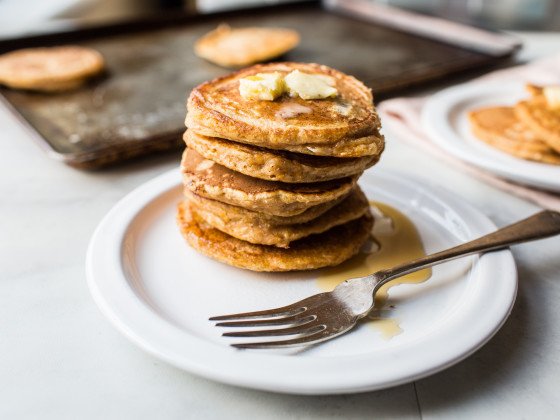
Light and Fluffy Pumpkin Pancakes Via food
With pumpkin as the main ingredient and flavor, you can already tell that this pancake is delicious and healthy as well. It also comes with other herbs and spices that make it truly bursting with flavor. To give you an idea, here are the ingredients needed for this recipe:
- All-purpose flour
- Milk
- Pumpkin
- Egg
- Sugar
- Baking powder
- Ground cinnamon
- Nutmeg
- Salt
- Butter
You can use low-fat milk in this recipe to minimize its fat content. It’s a very simple recipe that you can easily make in minutes.
Top 7 – Chocolate Chip Pancakes
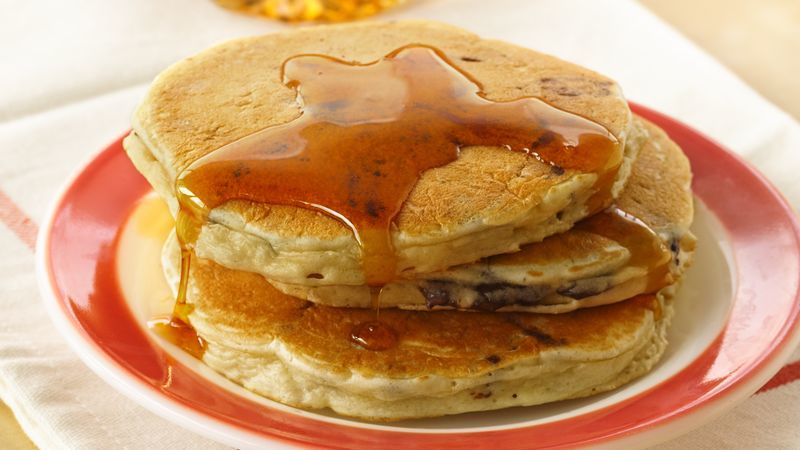
Chocolate Chip Pancakes Via bettycrocker
Satisfy your sweet cravings by making these extra yummy chocolate chip pancakes. Since the chocolate chips are stirred into the batter before cooking, these will serve as filling for the pancakes. In spite of its extraordinary taste, however, this recipe is actually very simple. In fact, you only need the following ingredients to make it:
- Bisquick Mix
- Milk
- Eggs
- Chocolate chips
Serve this pancake with Maple syrup if you want it extra sweet and extra yummy.
Top 8 – Ricotta Pancakes with Blueberry Filling
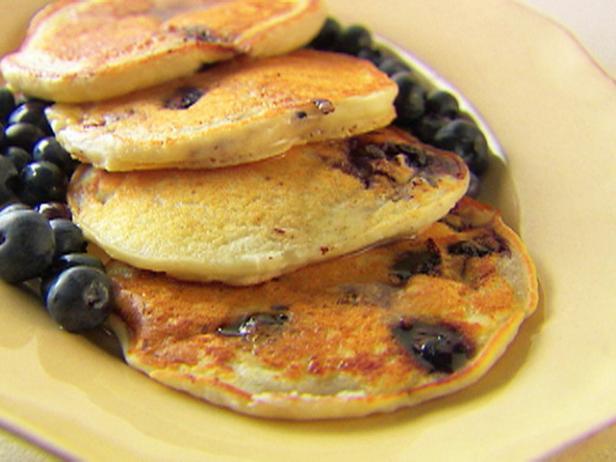
Ricotta Pancakes Via foodnetwork
Here’s an Italian-style pancake that’s very easy to prepare. Cheese always tastes good in pancakes – so, this is surely one flavorful recipe. Here are some of the ingredients you need for this particular recipe:
- Pancake and waffle mix
- Whole milk ricotta cheese
- Blueberries
- Water
- Sugar
- Honey
- Vanilla extract
- Butter
This recipe makes for really sweet pancakes. Aside from breakfast, you can also serve it as snacks and desserts.
Top 9 – Pecan Pancake

Maple Pecan Pancakes Via cooking.nytimes
This pancake recipe has pecan fillings for a truly delicious and nutritious treat. To make it, you need the following ingredients:
- All-purpose flour
- Milk
- Egg
- Toasted pecans
- Baking powder
- Sugar
- Salt
Everyone in your family will surely like these pecan-filled pancakes (at any time of the day)
Top 10 – Vegan Pancakes
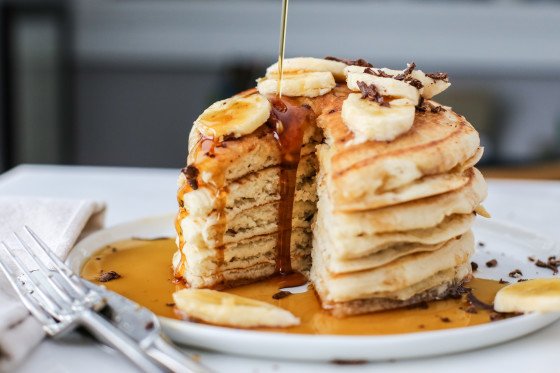
Vegan Pancakes Via food
For all the Vegans out there, this pancake recipe is for you. By the way, it’s not only vegan – it’s a delicious recipe as well (even non-Vegans will love it). Check out its ingredients:
- Whole wheat flour
- Soy milk
- Sugar (organic cane)
- Baking powder
- Salt
- Oil
See? You can be Vegan and still enjoy your pancakes.
Nutrition Facts of Pancakes
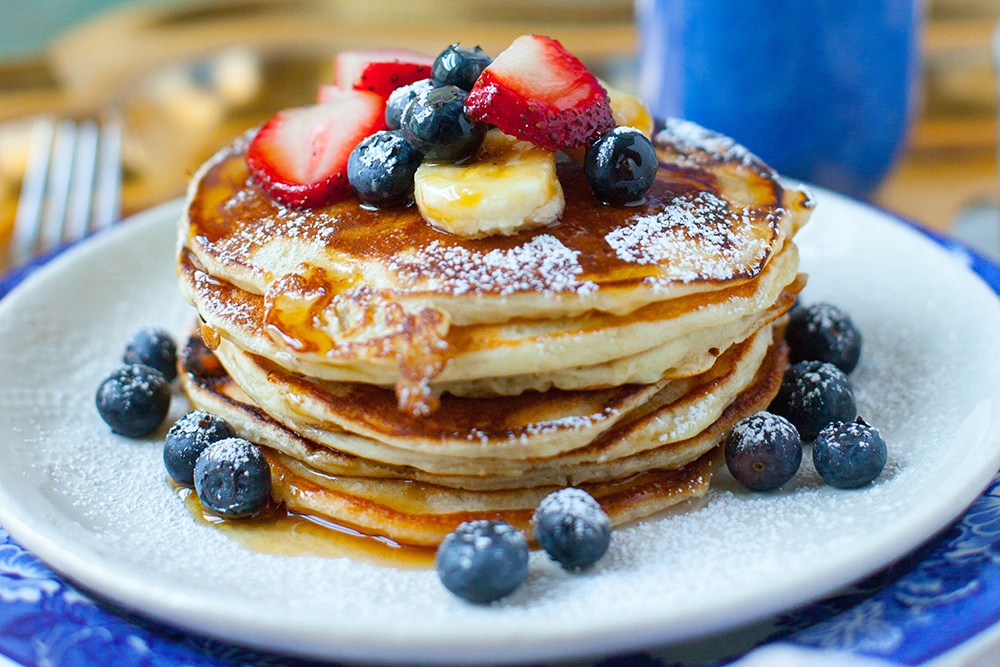
Pancakes
Nutrition Profile
Let’s look at the nutrition profile of pancakes based on a single serving of a basic 100-gram pancake (that’s about the size of 1 ½ pieces of a 6-inch diameter pancake)
- Calories – 230
- Protein – 6 g
- Carbohydrates – 30 g
- Fat – 10 g
- Saturated Fat – 2 g
- Sugar – 4.3 g
- Sodium – 308 mg
- Calcium – 20% DV
- Phosphorus – 15% DV
- Riboflavin – 15% DV
- Thiamin – 15% DV
- Iron – 10% DV
- Folate Acid – 10% DV
One serving of pancakes also contains small amounts of the following:
- Vitamin C
- Magnesium
- Zinc
- Copper
Using whole wheat flour in pancakes (instead of All-purpose flour) is healthier in a lot of ways. Just look at some of the points below.
- Fiber – 3 g
- Protein – 8 g
- Calcium – 25% DV
- Iron – 15% DV
- Phosphorus – 35% DV
- Riboflavin – 30% DV
Health Benefits of Pancakes
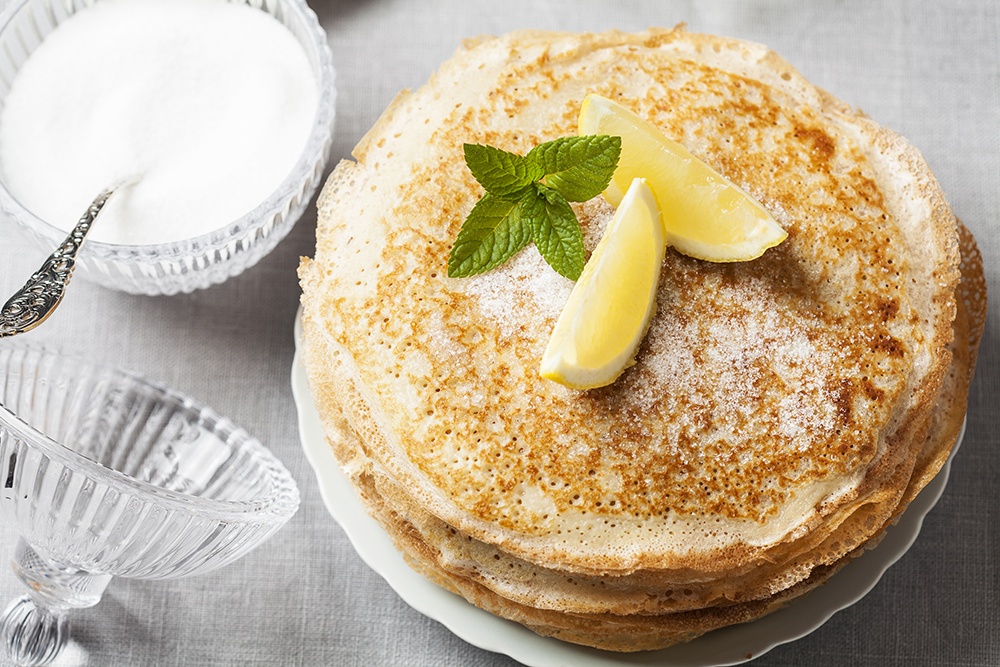
Pancakes
Pancakes from the most expensive restaurants may taste really good, but these may not be the healthiest (as a lot of sweet ingredients are usually added to the batter and pancakes themselves). However, when you make homemade pancakes from scratch, you can make these as healthy (and still delicious) as possible. Consider the following:
- Use whole wheat flour – Compared to All-purpose flour, this type of flour is higher in fiber, vitamins, and minerals.
- Use healthy toppings – Instead of syrup and butter, use fruits and nuts for toppings
- Make a healthy pancake batter – Incorporate chopped, grated, and mashed fruits and veggies for more vitamin and mineral content as well as flavor (e.g. blueberries, apples, bananas, pineapples, pumpkin, zucchini, carrots, sweet potatoes, etc.)
Health Concerns

Pancakes
Sure, we want to enjoy our pancakes, but let’s not neglect our health, too. Therefore, keep the following points in mind when eating pancakes:
- Adding oatmeal to the ingredients will increase the fiber content of pancakes.
- Using Maple syrup as the topping will increase a serving of Pancake's fat and calorie count
- For an added boost of protein, serve pancakes with eggs.
- Include Chia seeds and Flax seeds to pancake recipes to further increase their fiber content.
- Substitute butter (which is high in saturated fat) with almond butter.
- Make pancake batter naturally flavorful so as to limit the number of sweet toppings in the final serving.
- Even if you’re using healthy ingredients in your homemade pancakes, watch your consumption and portion size as pancakes are naturally high in calories.
FAQs
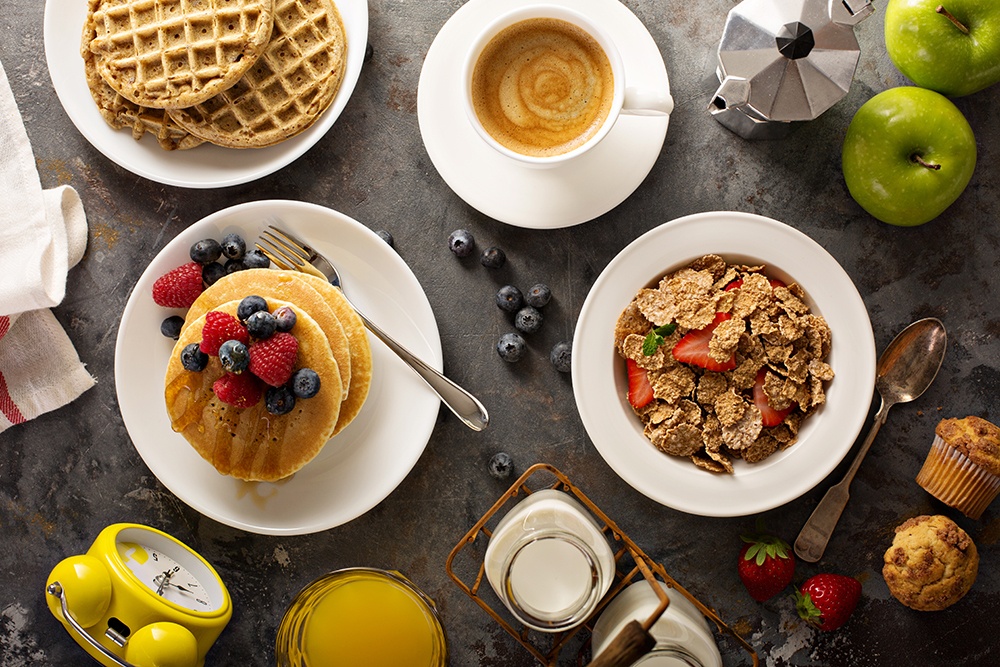
Pancakes
How much milk do you put in pancakes?
For 200 grams of flour, you can use about 350ml. to 400 ml. of milk. You can also substitute water to ½ of the milk requirement if you want your pancakes to be lighter in texture.
What type of flour do you use to make pancakes?
Typically, All-purpose flour is used in making pancakes. However, you can also use the following:
- Almond – gluten-free, adds sweetness to the batter.
- Barley – contains gluten, adds sweetness to the batter.
- Buckwheat – gluten-free, add earthy flavor to the batter
- Cornmeal – gluten-free, adds flavor to the batter.
- Garbanzo – gluten-free, high in protein and calcium
- Quinoa – gluten-free, high in protein
- Spelled – contains gluten, adds flavor to the batter.
- Teff – gluten-free, adds sweetness to the batter.
- Whole wheat – high in gluten, high in fiber, more nutritious than All-purpose flour.
Can you use wholemeal flour to make pancakes?
Yes, as you can see above, you can use whole wheat flour in making pancakes. Whole wheat is just the same as wholemeal, whole grain, and whole wheat.
What can you use in place of buttermilk?
You can use a lot of substitutes for buttermilk. The ingredients listed below can be combined with regular milk in order to make a buttermilk substitute:
- Lemon juice
- Vinegar
- Cream of tartar
- Plain yogurt
- Sour cream
- Coconut milk
What's the best way to eat pancakes?
You can eat pancakes any way you want to – one at a time or in stacks. It would be easier to manage each bite if you’re using knife and fork.
Should the butter on top of pancakes be salted or unsalted?
For topping, salted butter is best used as the saltiness adds flavor to the pancake. However, if you’re using butter for cooking or as an ingredient, unsalted butter is recommended so as to be able to control the amount of sodium in the batter.
What are the advantages of freezing pancake batter?
Having frozen pancake batter makes it easier to prepare breakfast in the morning (or when you have sudden cravings for pancakes). You can either thaw the batter overnight in the refrigerator or simply soak the batter container in warm water.
What is the purpose of leaving pancake batter to rest?
If you’re using flour that contains gluten, the gluten is activated during the mixing process of the batter. Allowing the batter to rest for a while also relaxes the gluten – which is important, as the presence of gluten makes pancakes tough instead of tender.
Conclusion: Enjoy Your Pancakes While Staying Fit and Healthy
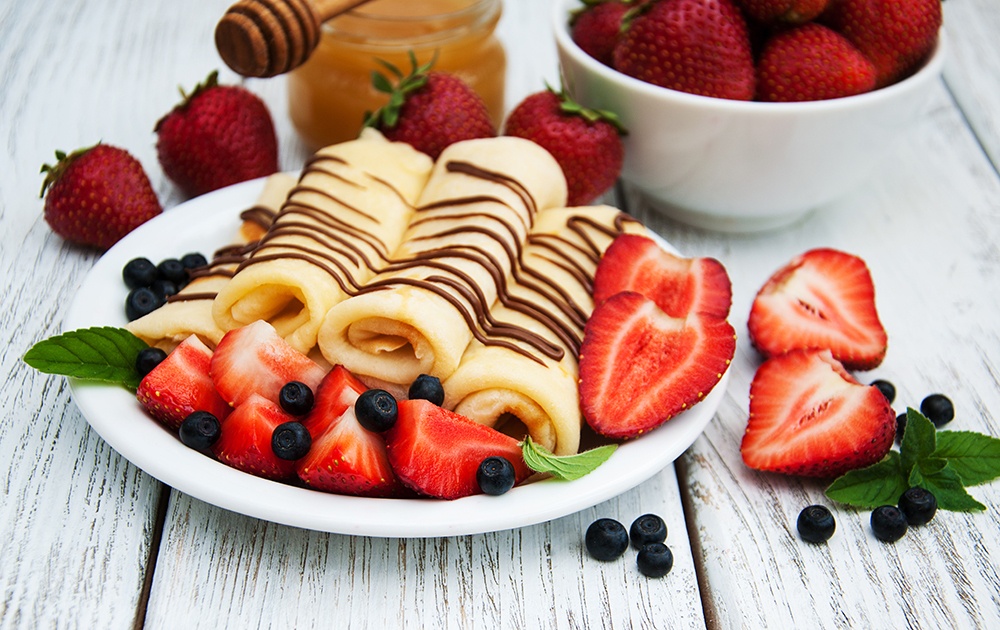
Pancakes
As pancakes are quite high in calories, I would suggest eating it in moderation. Using healthy ingredients such as natural sweeteners and fresh fruits will also make this type of food better. Well, better in the sense that fresh and natural ingredients are really more delicious, right?
Since pancake recipes are really very flexible, you can experiment with different fillings and toppings (just use your favorite ingredients). And if you are able to make tasty batter mixtures, you might not even need any fillings or toppings at all – or maybe, just butter.
Until next time, enjoy making delicious pancakes by following the instructions (and tips) in this post. Do let me know what you think, as I’m always eager to hear from you. And do share this article with your friends if you found it useful, ok?
Resources & Further Reading
- What is a Pancake? by Wikipedia.org
- The Difference Between Pancakes and Waffles by AltonBrown.com
- What’s the Difference Between Pancakes and Crepes? by ChowHound.com
- How to Make Pancakes by FirstWeFeast.com
- Alternative Flours by Epicurious.com
- How to Make Pancake Batter by WikiHow.com
- How to Make Pancakes without Baking Powder by Food.com
- How to Make Pancakes without Eggs by EgglessCooking.com
- How to Make Pancakes without Milk by Cooks.com
- How to Make Pancakes without Flour by EugenieKitchen.com
- How to Make Fluffy Pancakes by AllRecipes.com
- How to Freeze and Reheat Pancakes by GoodLifeEats.com
- How to Store Pancake Batter by Leaf.tv
- Tips to Making Great Pancakes by FineCooking.com
- Mistakes to Avoid When Making Pancakes by TheKitchn.com
- Common Pancake Cooking Mistakes by BonAppetit.com
- Tips for Better Pancakes by AllRecipes.com
- Tips to Making Pancakes by TheSpruce.com
- Benefits of Eating Pancakes by HealthyEating.SFGate.com
- Are Pancakes Healthy? by LiveStrong.com
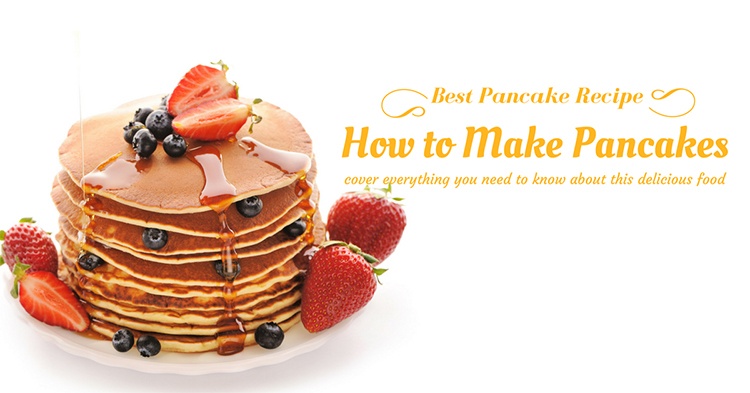
 30 Crockpot Recipes That Will Keep You Warm During the Cold Days
30 Crockpot Recipes That Will Keep You Warm During the Cold Days
Leave a Reply